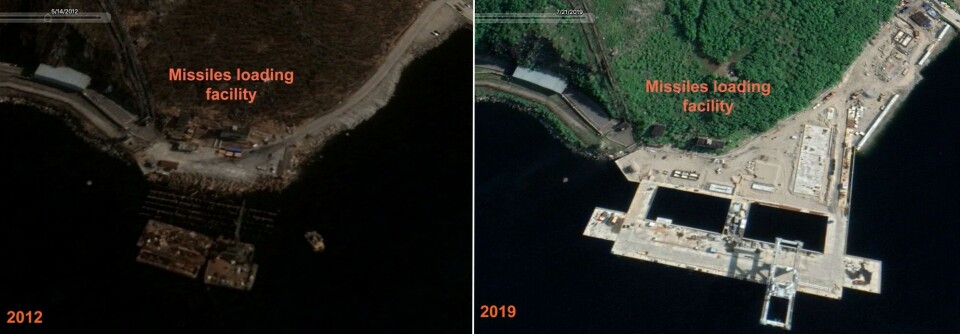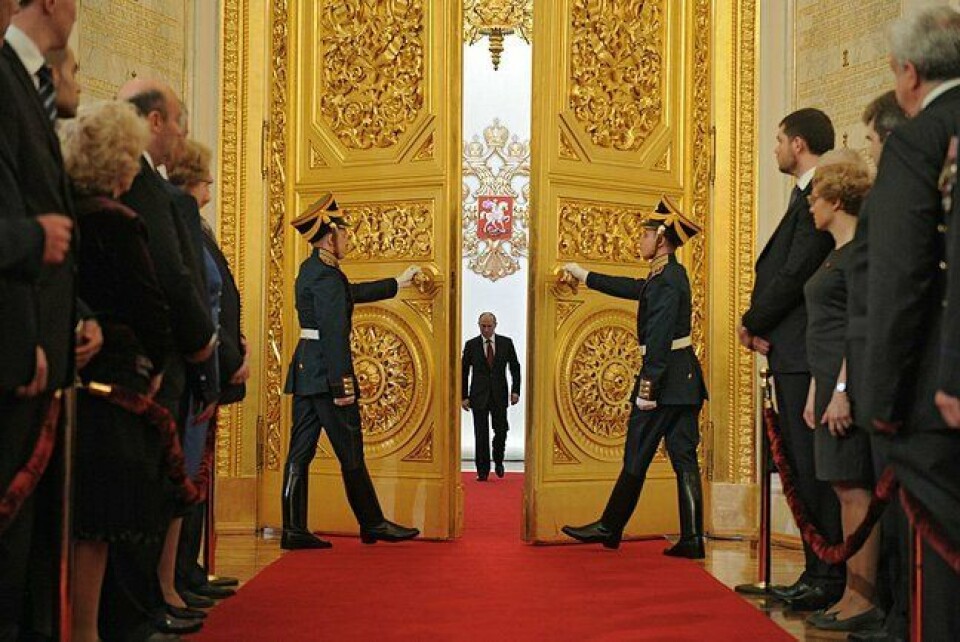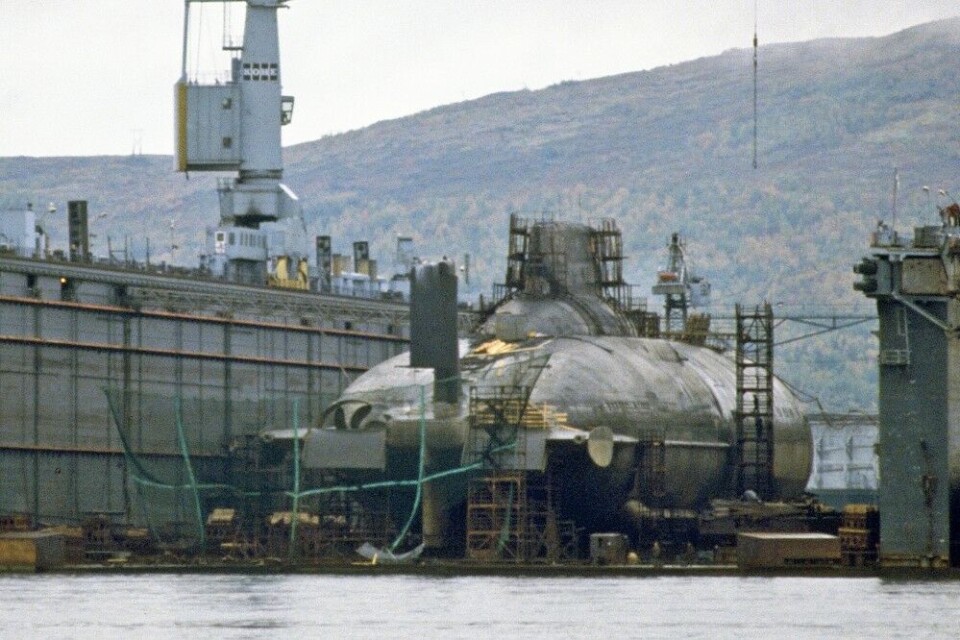
Northern Fleet makes major investments in nuclear submarine infrastructure. Will not repeat mistakes of the Cold War
Just a few hours after he was sworn in as Russia’s president for the third time, in May 2012, Vladimir Putin signed a decree ordering the development of the Navy in the Arctic. Now, eight years later, the results are highly visible on satellite photos of the Kola Peninsula. And more is to come.
The Barents Observer has for years studied satellite images of the Northern Fleet’s bases along the coast to the Barents Sea. Here are a few examples of what has happened in the course of the last eight years.
But first, let’s jump back in the timeline.

KREMLIN, MAY 7, 2012: The doors open and version 3.0 of Vladimir Putin enters St. Andrew’s Hall in the Grand Kremlin Palace in Moscow to be sworn in as president in a ceremony so overwhelming that thoughts went back to czarist Russia.
Putin himself, though, had a clear plan for the start of his third presidency.
Shortly after the lonely rider inauguration motorcade speeded away from the Kremlin, the president sat down behind his desk and started to sign decrees. Direct presidential orders to the government.
Modernization of the armed forces was one of the first decrees signed by Putin that day.
“The Government of the Russian Federation shall ensure a priority to nuclear weapons,” the text said. Paragraph C in the 3-pages decree highlighted “the development of the Navy, primarily in the Arctic zone.” By 2020, 70 percent of weapons and special equipment should be modern, President Putin demanded.
Eight years on
This week marks eight years since the decree was signed. And the president’s 2020 deadline is soon here. Judging from Google Earth satellite images, Putin got what he wanted.
The top photos in this article show a new loading facility for nuclear missiles at Okolnaya Bay, across the waters from the Northern Fleet’s headquarters and main naval base Severomorsk.
Okolnaya Bay is the largest weapon depot in northern Russia and covers a land area of about 15 square kilometers.

The satellite photo to the left was taken in May 2012, about at the time when Putin signed his decree to speed up the modernization of the nuclear submarine fleet’s infrastructure. As can be seen on the photo to the right, taken in summer 2019, the new huge port loading facility for the world’s deadliest weapons are nearly completed.
Unlike the old loading facility, located one kilometer to the north, the new facility has a big dedicated sidewise movable crane for loading and unloading ballistic missiles directly to the submarines. Here, the Borei class subs can be loaded with Bulava-missiles, or the Sineva missiles to the Delta-IV class subs can be handled.
The Russian Northern Fleet previously only had one such crane, found at the Gadzhiyevo where the Delta-IV and Borei are normally based. The six Delta-IV and two Borei SSBNs based with the Northern Fleet are the backbones of the sea-based component of Russia’s nuclear triad. Three or four more of the Borei-A class SSBNs currently under construction at the Sevmash yard in Severodvinsk are expected to sail for the Northern Fleet.
Nuclear warheads complex
In a previous satellite-study article, the Barents Observer outlined how about 50 brand new reinforces large weapons bunkers are erected in Okolnaya Bay. The bunkers could be used for both cruise missiles and ballistic missiles (SLBM).
Additionally, as can be seen on the two satellite images below, a brand new nuclear warhead complex is built in Okolnaya Bay. The left 2013 image shows construction work started, while the right 2019 image gives a bright view of the ready-to-use complex. Also, the right image shows four new 80-meters long bunkers for missiles’ carrier vehicles built after 2013 around the small lake on the hill to the right of the nuclear warhead complex.
The storage area is about 1,3 square kilometers, a size, and shape with a striking similarity to the pentagonal prism of the headquarters building of the United States Department of Defense.

In short, missiles are stored in the bunkers without the nuclear warhead mounted. Before being loaded on board a ballistic missile submarine, the missile is driven by a truck into the nuclear weapon complex where the warheads are attached. A closer look at the satellite image clearly shows a triple barbed wire security fence around the complex, similar to what other nuclear weapons storage sites on the Kola Peninsula have.
Also, the control-post for in-and-out going trucks seems to have a comprehensive security infrastructure.
Similarly, when a missile is unloaded from a submarine, the nuclear warhead will be separated and secured back inside the dedicated complex. Naturally, you don’t want to store a plutonium warhead together with missiles when not deployed onboard the vessel.
Cold War mistakes
The massive new infrastructure investments at the submarine bases along the coast of the Barents Sea shows that Putin’s Russia has learned from the mistakes of the Soviet Union. During the arms race of the Cold War, the Northern Fleet received 150 nuclear-powered submarines, many with cutting-edge technology.
But as the innovative submarines were transferred from the yard in Severodvinsk to active duty, the navy’s bases on the Kola Peninsula were not at all developed to serve the vessels. In the late 1970s and throughout the 1980s this became a huge challenge, both in regards to operating the submarines as the expensive high-tech submarines didn’t get the needed maintenance and weapons supply infrastructure to keep them operational at an optimal period of time.
For instance, the largest of all Soviet nuclear subs, the Typhoon-class known from Tom Clancy’s debut novel The Hunt for the Red October, never got needed port infrastructure. The six submarines of the class were based at the new-constructed Nerpichya in the Litsa fjord. Here, however, the onshore crane to load missiles to the subs was never delivered from the factory workshop building them in Ukraine.
The railway to deliver the missiles and other weaponry to the Litsa base was built in the 1980s, but never became operational.

Instead, the Northern Fleet had to use its missile transport ship «Aleksandr Brykin» to more or less constantly stay at the Nerpichya base to serve the Typhoons which each of them could carry 20 nuke-missiles.
The docking facilities for the Typhoon class were never completed at the base. Instead, a second-hand floating dock was bought from Sweden and towed to Roslyakovo yard in the Kola Bay, but it never really served the purpose for the giant Typhoons.
Also in the Litsa fjord, the base facilities for the expensive Alfa-class attack submarines were incomplete. Seven titanium-hull Alfa-submarines were built, all with a single liquid-metal cooled reactor. To avoid the liquid-metal from solidifying, something that would destroy the uranium core, it was necessary to keep the reactors constantly heated. The steam-motors, however, that were built at the piers to provide external heating proved to be unsatisfactory and soon broke down. Consequently, the reactors had to be kept running even while the submarines were at port. The reactors core logically got a much shorter life-time operation, and none of them were ever refueled.
Gadzhiyevo and Zapadnaya Litsa
Following Vladimir Putin’s 2012 decree, the Russian navy and the ministry of defense agreed to develop the needed comprehensive base structures to serve the new 4th generation of nuclear-powered submarines, that be the Borei-class and the Yasen-class.
For the Northern Fleet, the Borei-class subs carrying Bulava-missiles will all be based in Gadzhiyevo, while the Yasen class subs seem to be based in Zapadnaya Litsa. The prototype sub of the Yasen-class, the «Severodvinsk» is already based here and the second in the class, the «Kazan» will follow later this year.
The Russian Navy recently confirmed that five of the Yasen-class submarines will sail for the Northern Fleet, while the rest will belong to the Pacific Fleet.
The satellite images below show how the base infrastructure for the Borei-class at Gadzhiyevo has been improved since 2012. Onshore near the pier to the left, new facilities are built to support the submarines as they are being put into service. So far, the Northern Fleet has one vessel in operation, the «Yury Dolgoruky». The «Knyaz Vladimir» has for years been test-sailing out from the Sevmash yard and is expected to be delivered to the fleet later this year. Also «Knyaz Oleg» could be put into operation in the course of 2020.

According to an in-depth article in Izvestia in March, more work is underway both in Gadzhiyevo and in Zapadnaya Litsa (Zaozersk) with the construction of infrastructure facilities and shelters to support the new submarines.
At base, the submarines require electricity, compressed air, steam, and similar, Izvestia reports with unnamed sources in the navy command. New weapons and special equipment transport ships, like the «Akademik Aleksandrov» and the «Akademik Kovelyov», are already delivered to the Northern Fleet.
In December 2019, regional authorities in Murmansk presented an ambitious plan to knock down 400 shabby apartment blocks and build new ones in the closed naval towns along the coast to the Barents Sea. Over the next decade, some 80 new buildings will be built and another 1,100 will be renovated.
In these unsettling times, the Barents Observer needs your support more than ever. If you like what we’re doing, please consider making a donation. Your financial contributions, however big or small, will help keep our independent news coming from the north, about the north.
From Norway you can VIPPS: 105792
















